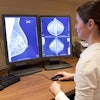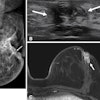Wednesday, December 3 | 12:15 p.m.-12:45 p.m. | BRS274 | Lakeside Learning Center
Screening recall rates for 2D digital mammography went down after digital breast tomosynthesis (DBT) was added into clinical practice, suggesting that DBT offers yet another benefit, according to research to be presented at this Wednesday poster session.Dr. Nicole Lee, of Dartmouth-Hitchcock Medical Center, and colleagues compared aggregate digital mammography recall rates from February 2010 through January 2012, before DBT began to be used, with rates from February 2012 through January 2014, after the technology was implemented.
They found that 2D recall rates were, indeed, lower after DBT began to be used, going from 8.81% to 7.89%. DBT also appeared to lower 2D digital mammography recall rates for women with heterogeneously dense tissue (10.68% before and 9.29% after), as well as for women with scattered dense tissue (8.58% versus 7.85%). The differences were statistically significant.
"The etiology of this effect is unclear but may be related to a learning curve from experience with [DBT]," Lee and colleagues wrote.




















